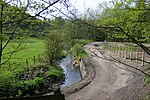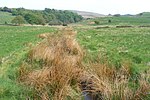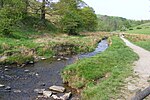Littleborough ( LIT-əl-bər-ə) is a town in the Metropolitan Borough of Rochdale, Greater Manchester, England, in the upper Roch Valley by the foothills of the South Pennines, 3 miles (4.8 km) northeast of Rochdale and 13 miles (20.9 km) northeast of Manchester; Milnrow and the M62 motorway are to the south, and the rural uplands of Blackstone Edge to the east. According to the 2001 census, Littleborough, and its suburbs of Calderbrook, Shore and Smithy Bridge, had a population of 13,807.
Within the boundaries of the historic county of Lancashire, Littleborough and its surroundings have provided evidence of Neolithic, Celtic, Roman and Anglo-Saxon activity in the area. During the Middle Ages, Littleborough was a hamlet in the manor of Hundersfield, parish of Rochdale and part of the Salford Hundred. It was focused upon the junction of two ancient routes over the Pennines — one of which may have been a Roman road — that joined to cross the River Roch. By 1472, Littleborough consisted of a chapel, a cluster of cottages, and an inn, and its inhabitants were broadly farmers who were spurred to weave wool by merchants who passed between the markets at Rochdale and Halifax. When cotton was introduced as a base to make textiles, Littleborough experienced an influx of families, mostly from the neighbouring West Riding of Yorkshire. Affluent homes and estates were established on Littleborough's fringes.In the late 18th century, the low-altitude Summit Gap between Littleborough and Walsden was approved as the best route over the Pennines for the Rochdale Canal and the Manchester to Leeds railway; Hollingworth Lake was built at Littleborough's south side as a feeder reservoir to regulate the waters of the canal. This infrastructure encouraged industrialists to modify Littleborough's traditional handloom cloth workshops with a mechanised form of textile production. Attracted to the area's natural resources and modern infrastructure, coal mining, engineering ventures and increasingly large textile mills contributed to Littleborough's population growth and urbanisation, sealing its status as a mill town. Local government reforms established the Littleborough Urban District in 1894 which was governed by its own district council until its abolition in 1974.
By the mid-20th century, imports of cheaper foreign goods prompted the gradual deindustrialisation of Littleborough, but its commercial diversity allowed it to repel the ensuing economic depression experienced elsewhere in North West England. Subsumed into the Metropolitan Borough of Rochdale in 1974, Littleborough endures as a commuter town with a distinct community; its Civic Trust works to preserve and enhance its historic character, and societies exist to use the surrounding countryside for water-skiing, horse riding and other recreational activities. Littleborough's stone-built town centre is designated as a Conservation Area for its special architectural qualities.






